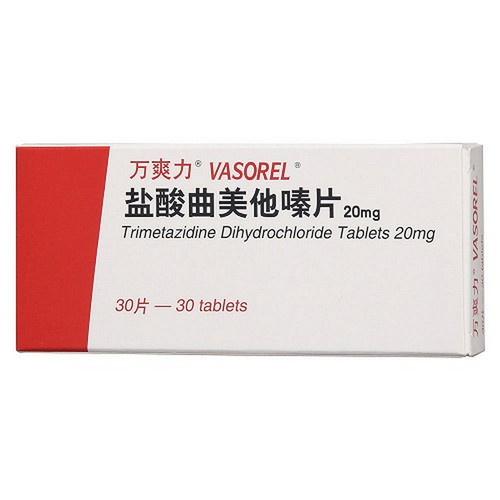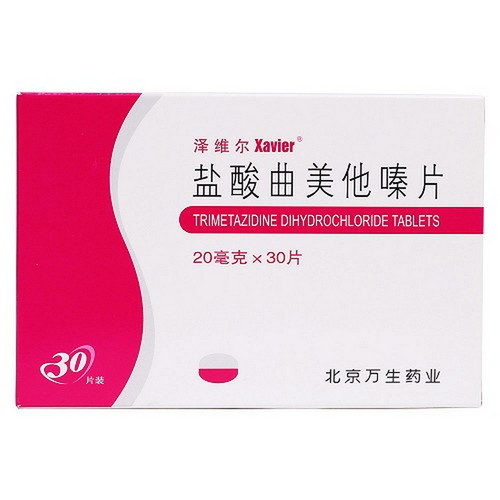Product Overview
[Drug Name]
Generic Name: Trimetazidine Hydrochloride Sustained-Release Tablets
Trade Name: Wanshuangli Trimetazidine Hydrochloride Sustained-Release Tablets 35mg x 30 Tablets
[Main Ingredients]
Each tablet contains 35mg of trimetazidine hydrochloride.
[Appearance]
This product is a pink film-coated tablet that appears white after removal of the film coating.
[Indications/Main Functions]
As an add-on medication, this product is indicated for the symptomatic treatment of adult patients with stable angina pectoris who are poorly controlled or intolerant of first-line anti-anginal therapy.
[Specifications]
35mg x 30 tablets (Wanshuangli)
[Dosage and Administration]
Take 35mg (1 tablet) twice daily, with breakfast and dinner. Evaluate treatment efficacy after three months; discontinue the drug if no therapeutic effect is seen. Patients with Renal Impairment: For patients with toxic renal impairment (creatinine clearance [30-60] ml/min) (see [Precautions] and [Pharmacokinetics]), the recommended dose is one 35mg tablet taken daily with breakfast.
[Adverse Reactions]
Gastrointestinal Disorders: Stomach pain, indigestion, diarrhea, constipation, nausea, and vomiting. Systemic Disorders: Asthenia. Neurological Disorders: Analgesia, dizziness, sleep disturbances (insomnia, hypersomnia), and worsening of Parkinson's symptoms, which resolve with discontinuation of the drug. Dermatologic Disorders: Rash, itching, urticaria, angioedema, and acute generalized pustular eruption. The onset of these reactions may vary, ranging from hours to days. Cardiovascular Disorders: Orthostatic hypotension, especially in elderly patients receiving antihypertensive therapy, which may be accompanied by syncope, dizziness, or falls; palpitations, extrasystoles, and tachycardia.
[Contraindications]
This drug is contraindicated in patients with hypersensitivity to any of the components. It is generally not recommended for use during breastfeeding.
[Drug Interactions]
To avoid potential drug interactions, you must inform your doctor or pharmacist of any other treatments you are taking.
[Precautions]
This drug is not intended for symptomatic treatment of angina pectoris or initial treatment of unstable angina or myocardial infarction. This medication should not be used for treatment before or during the first few days after hospitalization. During an angina attack, coronary artery disease should be reassessed, and treatment adjustments (medication and possible revascularization) should be considered.
[Pediatric Use]
The safety and effectiveness of this medication in children have not been established.
[Elderly Use]
See other sections or follow your doctor's advice.
[Overdose]
This medication should be taken exactly as prescribed. If you believe this medication is too strong or too weak, consult your doctor. If you suspect you have taken more than the prescribed dose, contact your doctor immediately. If you miss a dose, take the regular dose as planned for the next dose. Do not take a double dose to make up for a missed dose.
[Pharmacology and Toxicology]
This medication belongs to a class of other anti-anginal cardiovascular medications. Trimetazidine protects cellular energy metabolism during hypoxia or ischemia by preventing the decline in intracellular ATP levels, thereby ensuring the normal function of ion pumps and transmembrane sodium-potassium flux, and maintaining a stable intracellular environment. Animal studies have shown that trimetazidine: - Helps maintain energy metabolism in the heart and sensory organs during ischemia and hypoxia. - Reduces intracellular acidosis and ischemia-induced changes in transmembrane ion flux. - Reduces the migration and infiltration of polynuclear neutrophils during ischemia and myocardial reperfusion, and also reduces the size of experimental myocardial infarction. - This occurs without significant effects on hemodynamics. Human studies have shown that controlled trials in patients with angina pectoris have shown that trimetazidine: - Increases coronary flow reserve, thereby delaying the onset of exercise-induced ischemia starting 15 days after treatment. - Limits rapid blood pressure fluctuations without significant changes in heart rate. - Significantly reduces the frequency of angina attacks. - Significantly reduces nitroglycerin consumption.







